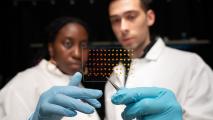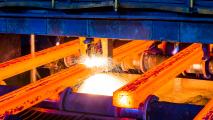This article is an installment of Future Explored, a weekly guide to world-changing technology. You can get stories like this one straight to your inbox every Thursday morning by subscribing here.
The Large Hadron Collider (LHC) is back after more than three years offline.
Since smashing its first particles in 2010, the LHC has led to some of the biggest discoveries in physics. Here’s everything you need to know about the massive machine, why it’s been down since 2018, and what sort of breakthroughs it might deliver next.
What is it?
The LHC is a particle accelerator, a machine that makes particles move really, really fast. There are thousands of particle accelerators across the globe, but the LHC is the biggest and most powerful.
While some particle accelerators are linear, the LHC is a circular tube. Thousands of magnets outside the tube guide beams of particles inside it around and around to greater and greater speeds — we’re talking just shy of the speed of light.
The European Organization for Nuclear Research (CERN) worked with scientists from more than 100 countries to build the LHC in an underground tunnel beneath the border of France and Switzerland, and it is massive, with a circumference of 17 miles and a diameter of 5 miles.
This size helps with the acceleration. The sharper the angle in a circular particle accelerator, the harder it is to control the particle beams within it at high speeds. A bigger circle means more gradual bends and less chance of the particles flying off course.

The LHC isn’t just a particle accelerator, though — it’s a particle collider.
That means scientists can send two beams of particles around and around the LHC in opposite directions and then smash them into one another once a target speed is reached. The fact that this is even possible makes the LHC an engineering marvel.
“The particles are so tiny that the task of making them collide is akin to firing two needles 10 kilometers apart with such precision that they meet halfway,” writes CERN.
Why smash particles?
LHC’s collisions take place inside detectors, which are located at different points all around the accelerator. These detectors record data about all the particles produced during the collisions, such as their speed and mass. Scientists then use this data to reconstruct the collisions.
This can lead to a better understanding of how the subatomic world operates or even to the discovery of new particles — the most well-known example is the discovery of the Higgs boson, also sometimes called the “God particle,” in 2012.

In the 1960s, physicists proposed that particles only gained mass after interacting with an invisible force field found throughout the universe (the Higgs field).
Confirming the existence of that field and the particle associated with it (the Higgs boson) was essential to confirming the Standard Model of Particle Physics, which is the current best explanation for what the universe is made of and how its fundamental building blocks interact.
The ‘60s-era scientists predicted what the Higgs boson would look like, but it wasn’t until a 2012 LHC experiment that a particle matching their predictions was finally observed, earning the scientists who proposed the Higgs boson a Nobel Prize in Physics.
Looking ahead
In December 2018, the LHC went on hiatus so that researchers could upgrade and service its accelerators and detectors, as well as add new experiments to the machine. On April 22, this hiatus ended with CERN restarting the LHC once again.
“The LHC itself … will now operate at an even higher energy and, thanks to major improvements in the injector complex, it will deliver significantly more data to the upgraded LHC experiments,” said Mike Lamont, CERN’s director for accelerators and technology.

The next few months will be spent preparing the LHC for its third run of experiments — that run will include more studies of the Higgs boson as well as experiments researchers hope will reveal another elusive particle: the one that makes up dark matter.
“When it’s a nice starry evening, and you look up to the sky, everything you see there is only 5% of what’s out there — the other 95% is still not understood,” Rende Steerenberg, CERN’s head of operations, told Popular Mechanics. “It would be very good if we could find hints of what this dark matter is, and perhaps find a dark matter particle.”
We’d love to hear from you! If you have a comment about this article or if you have a tip for a future Freethink story, please email us at [email protected].






